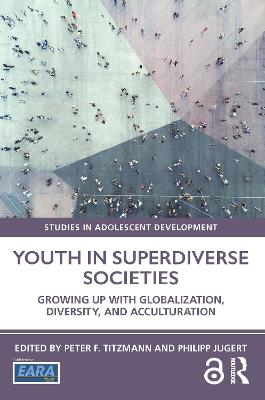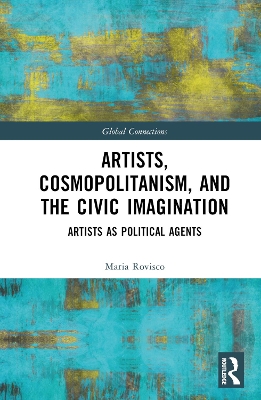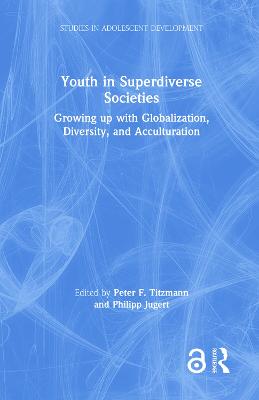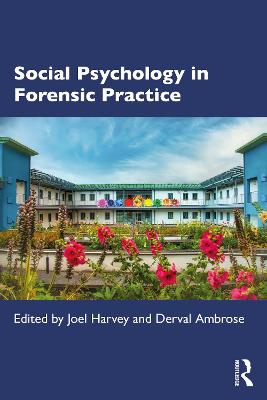Youth in Superdiverse Societies
 -10%
portes grátis
-10%
portes grátis
Youth in Superdiverse Societies
Growing up with globalization, diversity, and acculturation
Titzmann, Peter F.; Jugert, Philipp
Taylor & Francis Ltd
12/2019
314
Mole
Inglês
9781138488397
15 a 20 dias
520
Descrição não disponível.
Preface
Part 1: Conceptual Considerations
Chapter 1: Growing up with difference - superdiverse contexts as a habitual frame of reference
Chapter 2: Globalization and the proliferation of complex acculturation processes
Chapter 3: Biculturalism and Bicultural Identity Development: A Relational Model of Bicultural Systems
Chapter 4: Polyculturalism: Current Evidence, Future Directions, and Implementation Possibilities for Diverse Youth
Chapter 5: Towards a More Dynamic Perspective on Acculturation Research
Chapter 6: Development in context: The importance of country and school level factors for the mental health of immigrant adolescents
Part 2: Innovative Methods
Chapter 7: Applying experience-sampling methods to investigate the impact of school diversity on youth development in multicultural contexts
Chapter 8: Immigrant youth adaptation in multilevel context: Conceptual and statistical considerations
Chapter 9: The role of comparative research in understanding the diversity of immigrant youth
Part 3: Adolescents' Diverse Social Worlds
Chapter 10: Adolescent Language Brokers: Developmental and Familial Considerations
Chapter 11: Ethnic Majority and Minority Youth in Multicultural Societies
Chapter 12: A new agenda for examining interethnic interactions amongst youth in diverse settings
Chapter 13: Bridging Contexts: The Interplay between Parents, Peers, and Schools in Explaining Youth Reactions to Growing Diversity
Chapter 14: Understanding the Causes and Consequences of Segregation in Youth's Friendship Networks: Opportunities and Challenges for Research
Part 4: Preparing Societies for Dealing with Diversity Inside and Outside of Schools
Chapter 15: Participatory Approaches to Youth Civic Development in Multicultural Societies
Chapter 16: Teachers' dealings with ethnic diversity
Chapter 17: How to best prepare teachers for multicultural schools: Challenges and perspectives
Part 1: Conceptual Considerations
Chapter 1: Growing up with difference - superdiverse contexts as a habitual frame of reference
Chapter 2: Globalization and the proliferation of complex acculturation processes
Chapter 3: Biculturalism and Bicultural Identity Development: A Relational Model of Bicultural Systems
Chapter 4: Polyculturalism: Current Evidence, Future Directions, and Implementation Possibilities for Diverse Youth
Chapter 5: Towards a More Dynamic Perspective on Acculturation Research
Chapter 6: Development in context: The importance of country and school level factors for the mental health of immigrant adolescents
Part 2: Innovative Methods
Chapter 7: Applying experience-sampling methods to investigate the impact of school diversity on youth development in multicultural contexts
Chapter 8: Immigrant youth adaptation in multilevel context: Conceptual and statistical considerations
Chapter 9: The role of comparative research in understanding the diversity of immigrant youth
Part 3: Adolescents' Diverse Social Worlds
Chapter 10: Adolescent Language Brokers: Developmental and Familial Considerations
Chapter 11: Ethnic Majority and Minority Youth in Multicultural Societies
Chapter 12: A new agenda for examining interethnic interactions amongst youth in diverse settings
Chapter 13: Bridging Contexts: The Interplay between Parents, Peers, and Schools in Explaining Youth Reactions to Growing Diversity
Chapter 14: Understanding the Causes and Consequences of Segregation in Youth's Friendship Networks: Opportunities and Challenges for Research
Part 4: Preparing Societies for Dealing with Diversity Inside and Outside of Schools
Chapter 15: Participatory Approaches to Youth Civic Development in Multicultural Societies
Chapter 16: Teachers' dealings with ethnic diversity
Chapter 17: How to best prepare teachers for multicultural schools: Challenges and perspectives
Este título pertence ao(s) assunto(s) indicados(s). Para ver outros títulos clique no assunto desejado.
High Quality Civic Education;Immigration;Growth Mixture Modeling;cultural identity;Triadic Closure;ethnic identity;Bi-dimensional Frameworks;adolescent development;Ethnic Racial Identity Development;super-diversity;Negative Relationship;polyculturalism;Language Broker;ethnic majority youth;Intergroup Anxiety;multicultural societies;Acculturation Orientation;remote acculturation;Cross-ethnic Friendships;acculturation;Intergroup Contact;immigrants' social networks;Adolescent Language Broker;bicultural identity;Cross-group Friendships;family systems;Youth Attitudes;refugees;Cultural Streams;minority groups;Immigrant Youth;diaspora immigrants;CRT;immigration policies;Acculturation Processes;immigrant youth's well-being;Acculturation Research;adolescent acculturation;Heritage Language;cultural globalization;Immigrant Adolescents;ethnic diversity;Peer Diversity;cultural diversity;Interethnic Interactions;Friendship Segregation;Superdiversity Research
Preface
Part 1: Conceptual Considerations
Chapter 1: Growing up with difference - superdiverse contexts as a habitual frame of reference
Chapter 2: Globalization and the proliferation of complex acculturation processes
Chapter 3: Biculturalism and Bicultural Identity Development: A Relational Model of Bicultural Systems
Chapter 4: Polyculturalism: Current Evidence, Future Directions, and Implementation Possibilities for Diverse Youth
Chapter 5: Towards a More Dynamic Perspective on Acculturation Research
Chapter 6: Development in context: The importance of country and school level factors for the mental health of immigrant adolescents
Part 2: Innovative Methods
Chapter 7: Applying experience-sampling methods to investigate the impact of school diversity on youth development in multicultural contexts
Chapter 8: Immigrant youth adaptation in multilevel context: Conceptual and statistical considerations
Chapter 9: The role of comparative research in understanding the diversity of immigrant youth
Part 3: Adolescents' Diverse Social Worlds
Chapter 10: Adolescent Language Brokers: Developmental and Familial Considerations
Chapter 11: Ethnic Majority and Minority Youth in Multicultural Societies
Chapter 12: A new agenda for examining interethnic interactions amongst youth in diverse settings
Chapter 13: Bridging Contexts: The Interplay between Parents, Peers, and Schools in Explaining Youth Reactions to Growing Diversity
Chapter 14: Understanding the Causes and Consequences of Segregation in Youth's Friendship Networks: Opportunities and Challenges for Research
Part 4: Preparing Societies for Dealing with Diversity Inside and Outside of Schools
Chapter 15: Participatory Approaches to Youth Civic Development in Multicultural Societies
Chapter 16: Teachers' dealings with ethnic diversity
Chapter 17: How to best prepare teachers for multicultural schools: Challenges and perspectives
Part 1: Conceptual Considerations
Chapter 1: Growing up with difference - superdiverse contexts as a habitual frame of reference
Chapter 2: Globalization and the proliferation of complex acculturation processes
Chapter 3: Biculturalism and Bicultural Identity Development: A Relational Model of Bicultural Systems
Chapter 4: Polyculturalism: Current Evidence, Future Directions, and Implementation Possibilities for Diverse Youth
Chapter 5: Towards a More Dynamic Perspective on Acculturation Research
Chapter 6: Development in context: The importance of country and school level factors for the mental health of immigrant adolescents
Part 2: Innovative Methods
Chapter 7: Applying experience-sampling methods to investigate the impact of school diversity on youth development in multicultural contexts
Chapter 8: Immigrant youth adaptation in multilevel context: Conceptual and statistical considerations
Chapter 9: The role of comparative research in understanding the diversity of immigrant youth
Part 3: Adolescents' Diverse Social Worlds
Chapter 10: Adolescent Language Brokers: Developmental and Familial Considerations
Chapter 11: Ethnic Majority and Minority Youth in Multicultural Societies
Chapter 12: A new agenda for examining interethnic interactions amongst youth in diverse settings
Chapter 13: Bridging Contexts: The Interplay between Parents, Peers, and Schools in Explaining Youth Reactions to Growing Diversity
Chapter 14: Understanding the Causes and Consequences of Segregation in Youth's Friendship Networks: Opportunities and Challenges for Research
Part 4: Preparing Societies for Dealing with Diversity Inside and Outside of Schools
Chapter 15: Participatory Approaches to Youth Civic Development in Multicultural Societies
Chapter 16: Teachers' dealings with ethnic diversity
Chapter 17: How to best prepare teachers for multicultural schools: Challenges and perspectives
Este título pertence ao(s) assunto(s) indicados(s). Para ver outros títulos clique no assunto desejado.
High Quality Civic Education;Immigration;Growth Mixture Modeling;cultural identity;Triadic Closure;ethnic identity;Bi-dimensional Frameworks;adolescent development;Ethnic Racial Identity Development;super-diversity;Negative Relationship;polyculturalism;Language Broker;ethnic majority youth;Intergroup Anxiety;multicultural societies;Acculturation Orientation;remote acculturation;Cross-ethnic Friendships;acculturation;Intergroup Contact;immigrants' social networks;Adolescent Language Broker;bicultural identity;Cross-group Friendships;family systems;Youth Attitudes;refugees;Cultural Streams;minority groups;Immigrant Youth;diaspora immigrants;CRT;immigration policies;Acculturation Processes;immigrant youth's well-being;Acculturation Research;adolescent acculturation;Heritage Language;cultural globalization;Immigrant Adolescents;ethnic diversity;Peer Diversity;cultural diversity;Interethnic Interactions;Friendship Segregation;Superdiversity Research







